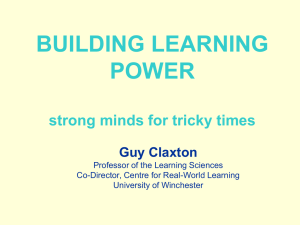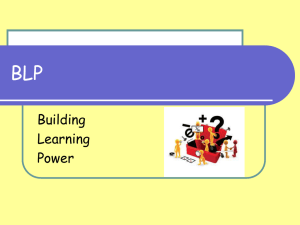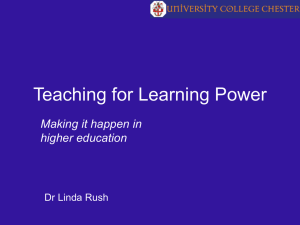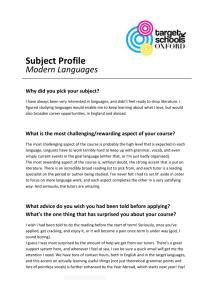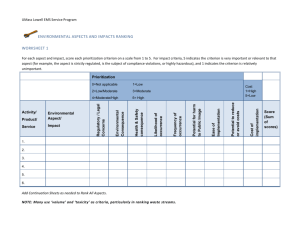BUILDING LEARNING POWER
advertisement
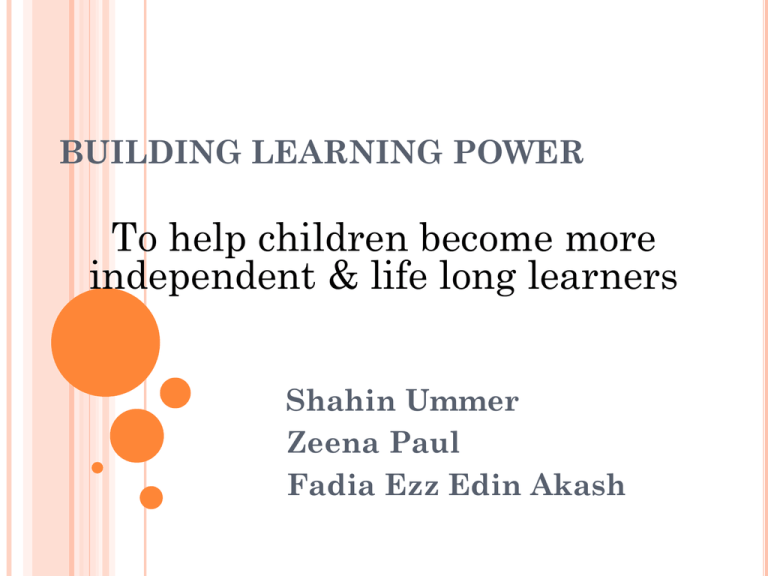
BUILDING LEARNING POWER To help children become more independent & life long learners Shahin Ummer Zeena Paul Fadia Ezz Edin Akash These are the four main learning dispositions Resilience Resourcefulness Reflectiveness Reciprocity CREATED BY PROFESSOR GUY CLAXTON These dispositions are inherent in all They are not fixed at birth, or when we leave school They can be developed by everyone regardless of ‘ability’, social background or age. THE 4 R’S OF BUILDING LEARNING POWER 1) Resilience This is the emotional aspect of learning. THE 4 R’S OF BUILDING LEARNING POWER 2) Resourcefulness The cognitive aspect of learning THE 4 R’S OF BUILDING LEARNING POWER 3) Reflectiveness This is the strategic aspect of learning. THE 4 R’S OF BUILDING LEARNING POWER 4) Reciprocity This is the social aspect of learning. THE LEARNING MUSCLES FOR ALL ROUND LEARNING FITNESS The 4 R’s can be thought of as being groups of ‘LEARNING MUSCLES’ We can exercise our learning muscles to develop their strength and stamina SOME ASPECTS OF BLP CULTURE The Teacher Language-talking about learners and learning Example- KWHL The Classroom-split screen lessons Environment- e.g. displays CLASSROOM CULTURE & TEACHERS ROLE FOR LEARNING WARMER Think of a Team sport …. What Makes a good team ? HOW CAN WE BUILD LEARNING POWER Classroom Practice Organization of lessons Physical Environment Development of Teachers Leadership of the school TEACHING PALETTE Explaining Modelling Orchestrati ng Commentatin g Explaining • Teachers introduce directly and explicitly to the 4R’s of learning power and train them how to use them Orchestrating • Teachers orchestrate resources , the environment and activities for BLP Commentating • Teachers commentate on children’s learning power through informal talk and formal or informal evaluation Modelling Teachers model being a learner , getting stuck , trying things out and making TOOLS FOR BUILDING LEARNING POWER Explaining Commentating Orchestrating Modelling Informing providing information about overall purpose of learning Reminding – Drawing attention and prompting about specific aspect of learning Evaluating – Nudging – asking commenting on explanatory learning and its questions and outcome skilfully moving the learners Selecting – Target setting – choosing ways of helping learners working and set and monitor designing activity their own targets Learning aloud – learning and thinking in front of the class Reacting – responding to unexpected with curiosity Discussing – Discussing how to develop learning power and inviting contributions Replying – providing written or spoken feedback Training – Directing ways to build learning capacity Framing – clarifying the learning power expectations behind all activities Sharing – Showing you value learning and confident in yourself as a learner and sharing your experience Arranging – Deploying resources and arranging the environment to support learning Demonstrating – showing that your learning includes different activities like drafting , sketching , reflecting Tracking – capturing the progress each students makes WHAT HAPPENS ….. Enlivening attitudes to learning Raising attainment Deepening learning Giving students a learning voice Reducing behaviour problems Exciting classroom practitioners Preparing for a Lifetime of learning
